Guide to Garden Shrubs
Shrubs are small to medium-sized woody plants distinguished from trees due to their multiple stems branching from the base and shorter height, although some plants can grow into either shrubs or trees depending on the growing conditions. They provide an array of foliage colours, vibrant stems, stunning flowers, berries, autumnal colour and beautiful fragrances. Shrub are used to provide a basic structural framework in garden borders and are categorised as either evergreen (retain their leaves through the winter) or deciduous (drop their leaves in the autumn). Some fall somewhere in between the two and are called semi-evergreen, losing their leaves only during particularly cold winters or colder regions of the UK.
Choosing a Shrub
Shrubs vary significantly in size, shape, growth habit and special features, as well as the conditions where they will succeed, but the huge range of plants within the category means there will inevitably be something to suit the exact conditions and provide the specific qualities you're looking for. Selecting a shrub that's suitable for the conditions in your garden is the first step to effective garden care, so choose carefully. We've provided a guide to some of the best types of shrub varieties below including links to more information on our favourites.
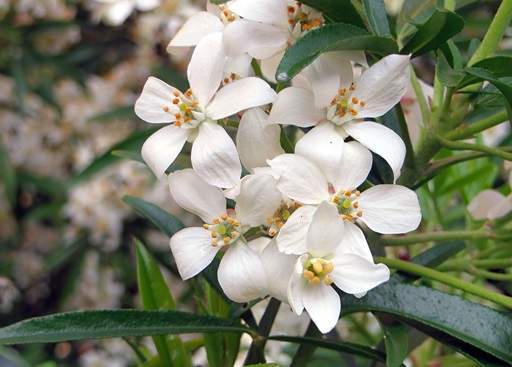
Planting
Containerised shrubs can be planted at any time providing the ground is not frozen or waterlogged, although October to April is often best as this is when they will be dormant and best able to establish more quickly in the spring. Root balled and bare root plants must be planted as soon as possible after purchase between October and April. If the planting site is not immediately ready, they should be “heeled in” until they are ready to be planted properly.

Growing Shrubs in a Container
Some small to medium sized shrubs also grow well in containers, which is a good option if you want to add a splash of colour to the patio. Select the size of the container based on the eventual height and spread of your shrub and pot up using a suitable compost - multi-purpose is fine for most varieties but ericaceous compost is a must for acid-loving plants. other garden care steps are the same as for growing shrubs in the ground (see below) but you'll need to pay special attention to feeding your plant regularly during the summer.
Garden Care
Growing Conditions
Some shrubs such as Camellia bushes dislike lime and must be grown in an acidic, ericaceous compost to succeed. Varieties such as Choisya will do best in a well-drained, fertile soil, whilst others like Cornus are unfussy, making them great for a less fertile or boggy part of the garden.
Watering and Feeding
Shrubs are generally easy to grow and undemanding. Watering is recommended when newly planted but most varieties will become drought tolerant once established. Feeding annually in late winter with a general purpose fertiliser usually does the trick for shrubs grown in the border, although container-grown specimens may need a couple of extra boosts over the summer as they have less soil from which to draw nutrients.

Weeding and Mulching
Weed around your shrubs as and when necessary during the growing season. Larger weeds should be hand pulled from the soil ensuring that all of their roots (including all of the tap root where appropriate) are removed. Smaller weeds can often be removed more easily with a hoe.
Apply a generous mulch of bark around the base of your plants after planting and annual each year in late winter to help suppress weeds and retain moisture.
Cold Protection
Ability to withstand the winter cold varies by variety and is indicated by their hardiness. Whilst some will stand up to the harshest of conditions, others will require shelter and cold protection such as a sheltered wall, horticultural fleece or even being moved to a greenhouse (for specimens grown in a container). Make sure you factor in the hardiness of plants relative to your conditions when choosing a shrub for your garden.
Shrubs by Variety
Some of the most popular types of shrubs are listed below: -
Versatile foliage shrub for almost anywhere in the garden, including shady areas where other varieties will struggle. Low maintenance and drought tolerant once established. Prune between March and late spring.
Choose Aucuba Crotonifolia for gold-blotched, finely speckled leaves (best in full), Aucuba Pepperpot for glossy green leaves covered in tiny bright golden spots, Aucuba Picturata for stunning large bright green leaves with a central bright golden splash with small purple-red flowers and bright red berries, or Aucuba Rozannie for orange-red berries against a backdrop of deep glossy green leaves that works well with spring bulbs.

Dense, upright evergreen shrub with spiny margined leaves and thorny stems, plus spring flowers. Perfect as a low maintenance shrub for beginner gardeners, particularly as a strong, impenetrable hedge, just make sure you have a pair of protective gloves for handling and planting!
Choose Berberis Darwinii for small, spiky, dark green leaves and pendant, golden-yellow flowers, Berberis Julianae for clusters of yellow, red-tinged flowers and attractive red autumn foliage colour, Berberis Golden Rocket for outstanding bright golden foliage, Berberis Admiration for yellow-edged, purple-red ovate leaves and Berberis Helmond Pillar if you're looking for a dwarf variety (1-1.5m tall) with a very erect growth habit.

Known as the butterfly bush in recognition of its ability to attract wildlife to the garden, Buddleias provide a natural feel to the garden with a slightly sprawling growth habit and attractive flower spikes on long stems. It has silvery, grey-green foliage which darken as they mature and a sweet honey scent. Best grown in a sheltered, sunny spot.
Choose Buddleia Lochinch for pale purple flowers fading to white in the centre with an attractive orange eye, Buddleia Ivory for subtle ivory-cream flowers and a denser, more upright habit suitable for growing in a container, Buddleia Nanho Blue for arching stems and large clusters of fragrant rich violet-blue flowers or Buddleia Sungold for spherical clusters of deep yellow, heavily scented flowers.

Stunning, semi-double flowers set against a backdrop of glossy, dark green evergreen leaves. Suitable for container growing on the patio or in the border. Grows best in a sunny, sheltered position with a lime-free soil and ericaceous compost.
Camellia E.G. Waterhouse is a hardy variety with bright pink blooms suitable for the harshest conditions, Camellia Adolphe Audusson produces large, saucer-shaped, semi-double dark red flowers with prominent yellow stamens, Camellia Desire has white flowers that become pink tinged towards the edges and Camellia Donation for free-flowering, light pink blooms which smother the bush throughout spring.

Fast growing evergreen bush with a compact growth habit, bright glossy green foliage and attractive flower panicles. Best protected from cold, drying winds.
Choose Ceanothus Autumnal Blue for a hardy variety with rich blue flowers from spring to summer, Ceanothus Blue Cushion for beautiful, fluffy bright blue flowers borne in clusters from August to September and Ceanothus Pershore Zanzibar for light green foliage that becomes almost golden in the summer and light blue/lilac flowers attractive to bees and butterflies.

Low maintenance bush with sweetly scented flowers and aromatic foliage, best grown near a seating area of patio where the fragrance can be best appreciated on hot sunny days.
Choose Choisya Goldfingers for narrow golden yellow leaves and showy clusters of white spring flowers, Choisya Ternata for masses of white/pink flowers above shiny, dark green evergreen leaves, Choisya Ternata Sundance (Mexican Orange) for golden yellow foliage, a citrus scent and white winter/spring flowers or Choisya White Dazzler for dazzling white scented flowers and a compact growth habit.

The elegant 'rock rose' has a dense, rounded growth habit with attractive but tender, grey-green leaves. It produces masses of papery flowers with out-stretched petals usually from early to mid-summer. Suitable for growing in a container.
Choose Cistus silver Pink for light, blush-pink flowers with a golden-yellow centre, Cistus Decumbens for luminous, snowy white flowers and Cistus Purpureus for large, rounded, dark pink blooms with a distinctive maroon mark at the base of each petal. If you're keen to grow a Cistus but need something hardier, choose Cistus Hybridus (also known as Cistus Corbariensus), which has white flowers with yellow centres.

Known as dogwood, Cornus is a hardy deciduous shrub with strong, upright and often colourful stems which grow quickly from the base. Best suited to a partially shaded position, it is hardy, tolerant of wet soils and low maintenance.
Choose Cornus Alba Aurea for large crisp yellow leaves in spring followed by florets of small white flowers in June, Cornus Elegantissima for attractive cream-green variegated leaves which turn to bright orange-red before dropping in autumn or Cornus Sibirica for stunning deep red autumn foliage and creamy-white flower heads followed by white fruits.

Compact small to mid-sized, semi-evergreen bush with attractive, colourful ovate leaves and panicles of fluffy summer flowers which are so light and wispy they have given Cotinus the name "smoke bush". Fits in well in a variety of planting schemes and makes an excellent specimen plant for a sunny spot of the garden. Needs a warm, sunny, open position to perform best.
Choose Cotinus Golden Spirit for rich, golden-yellow leaves that take on brilliant shades of coral, orange and red in the autumn and feathery racemes of pale pink flowers in the summer or Cotinus Royal Purple for soft deep maroon-purple leaves and clear pink flower plumes.

Versatile evergreen shrub great for growing as an informal hedge or as part of a large shrub border. Produces fragrant, urn-shaped flowers from summer to autumn. Tolerant of dry soil and salt-laden coastal winds.
Choose the popular Elaeagnus Gilt Edge for glossy, dark green leaves with bold, golden-yellow variegation which produces fragrant, creamy-white flowers in October.
Alternatively, Elaeagnus Maculata offers fragrant, urn-shaped creamy-white flowers above more blotchy and speckled golden yellow and deep green leaves with slightly spiny branches.

Typically used as a staple variety for the garden border, Euonymus can also be useful for incorporating into mixed hedges, attracting wildlife to the garden and adding winter interest.
Choose the ever popular Euonymus Emerald and Gold if you're looking for a dwarf evergreen with bright golden-yellow variegated leaves that take on stunning shades or red and pink during the winter, Euonymus Red Cascade for fantastic scarlet-red autumn foliage colours, small pink flowers and pinky-orange winged fruits or Euonymus Europaeus for unusual yellow flowers and red fruits with orange seeds.

Bold shrubs with large deeply-lobed evergreen leaves great for adding a tropical feel and architectural structure to your garden.
Fatsia Japonica is tolerant of salt-laden winds, making it suitable for seaside locations, whilst also being suitable for growing indoors. Fatsia Spiders Web has glossy green leaves speckled with creamy white. Both produce clusters of small, delicate white flowers in autumn, followed by inedible black fruits.

Much loved by many gardeners due to their enthusiastic growth and bright winter colour. Forsythia has an upright growth habit and early spring flowers emerging on bare stems. It is named after William Forsyth (1737 - 1804) a Scottish botanist who was royal head gardener and a founding member of the RHS.
Choose Forsythia Maree D'Or Courtasol for an abundance of yellow flowers throughout late winter, right through to early spring or Forsythia Lynwood for large, rich yellow blooms which smother bare stems in March and April. Forsythia Week End 'Courtalyn is another option for bright golden flowers throughout spring which looks particularly striking alongside Cornus varieties.

Bushy upright shrub with distinctive showy flowers and a fast growth habit. Best grown with some protection from cold, drying winds, although any frost damage is usually quickly revived in the spring.
Choose Fuchsia Mrs Popple for large, attractive, drooping red and dark purple flowers borne repeatedly through summer and autumn above a backdrop of elongated, dark green leaves. Alternatively Fuchsia Riccartonii produces single, scarlet and purple drooping flowers and is ideal for adding a splash of colour to borders, pots or hanging baskets.

Small, hardy evergreen shrub producing bell-shaped flowers above glossy green leaves from May to June. The star attraction are the large, colourful berries which are held well into the autumn and look stunning at the front of a border or in a patio container. Grow all other varieties close to Gaultheria Mucronata (Male) for the best display of berries and select a loamy, acidic site. Tolerant of wet soils.
Choose Galtheria Alba for pinkish-white flowers, attractive bronze autumn foliage colour and masses of pure white berries, Gaultheria Rosea for shiny, light pink fruits or Gaultheria Rubra for deeper red fruits. One male Gaultheria Mucronata (Male) should be planted for every five of the female varieties listed above (produced flowers but no berries).

Large, deciduous upright shrub with large hazel-like leaves and ribbon-like flowers with a sweet fragrance borne on bare branches during the winter. Ideal for using as a specimen plant or in a large container, Hamamelis will add a splash of colour to the winter garden and rival any Japanese Maple for autumnal foliage colour.
Choose Hamamelis Diane for ruby-red flowers with a sweet fragrance that's perfect for growing alongside the bright bark of dogwoods, Hamamelis Jelena for majestic flowers in spectacular shades of yellow, orange and red, giving the appearance of a burning flame or Hamamelis Pallida for fabulously fragrant, pale yellow branches.

Beautiful rounded evergreen shrub with luscious, ovoid thick green leaves, reddish-bronze stems and dense flower spikes from late summer through autumn. Excellent specimen shrub or hedge, particularly as its late blooms help to add a splash of much needed colour to the garden in early autumn. Low maintenance and attractive to bees and butterflies.
Choose Hebe 'Silver Dollar' for dark green leaves with attractive, deep violet-purple edging and mid-ribs and rich violet-blue flower spikes, Hebe Champagne for lilac flowers which fade to white as the season progresses and Hebe Heartbreaker for attractive mauve flowers through summer and grey-green leaves with a bold cream variegation and purple tinge in winter and spring. Last but not least the popular classic Hebe Midsummer Beauty offers lilac flowers that fade to white, great for the front of a border.
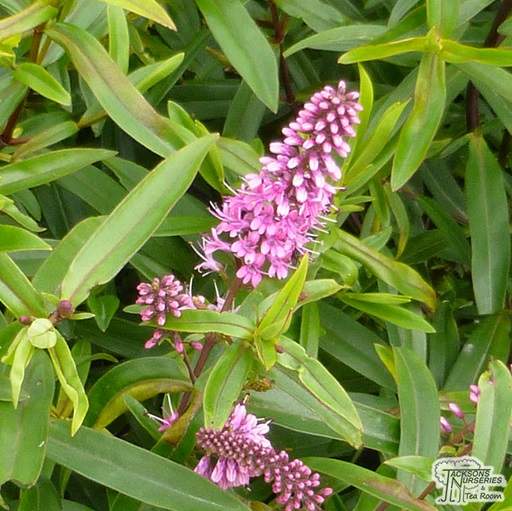
Compact growing shrub with large, striking rounded flower heads in a range of beautiful colours above shiny, mid-green leaves. To get the best out your hydrangea you'll need to keep it well watered during periods of dry weather.
Choose Hydrangea Alpengluhen for striking red-pink flower heads which take on shades of lavender, blue and mauve in slightly acidic soils, Hydrangea Bodensee for a heavy blooming variety with large blue flower heads, Hydrangea Madame Emile Mouillere for impressive florets of large white flowers or Hydrangea Grandiflora for large, cone-shaped white flowers.

Lush semi-evergreen shrub bearing attractive fragrant flowers from late summer through autumn above lance-shaped mid-green leaves. Best protected from winter frosts and cold, drying winds, although if it does die back to the ground in winter, new shoots typically develop from the base in spring.
Choose Hypericum Hidcote for waxy, golden-yellow cupped flowers borne on twiggy stems or Hypericum Magical Beauty for yellow flowers in summer followed by an abundance of autumn berries that change colour from butter yellow, shell pink, deep red and later black. Alternatively, Hypericum Magical Red offers glowing red berries in autumn and looks superb in planters and for flower arranging.
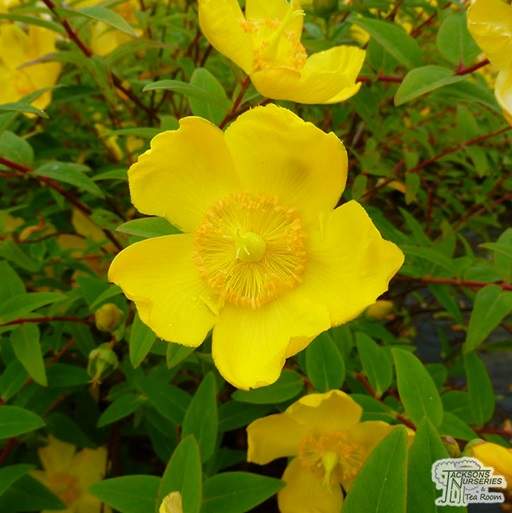
Distinctive evergreen shrub with spiky, glossy green leaves and autumn berries. Common holly is a staple for any garden, but there are many other varieties too.
Choose Ilex Aquifolium (common holly) for its distinctive spiky leaves and deep red autumn/winter berries, Ilex Bacciflava for a female holly with rich, glossy, spiny dark green leaves and an abundance of bright yellow berries in autumn (needs a male to fruit) or Ilex Silver Milkmaid for a variegated variety with bronzy young leaves that develop a bright creamy central splash on a bright green background. Alternatively, Ilex Blue Prince has purplish-green young branches and makes a great holly for hedging or as a specimen shrub.

Best known for its distinctly fragrant flowers and aromatic foliage, lavender produces short spikes of sweetly scented flowers on long stems above a compact mass of silvery-grey foliage. Superb as specimen plants in planters, around the edge of seating areas and patios, or as a lower hedge.
The most popular varieties are Lavender Hidcote and Lavender Munstead both with violet blue flowers and aromatic evergreen foliage. Other varieties are Lavender Rosea with dense racemes of pastel rose-pink flowers, Lavender stoechas (French Lavender) for bulbous flower heads that erupt with pale pastel mauve flowers with a butterfly-wing appearance and Lavender Stoechas, a dwarf variety from the Mediterranean with long purple flowers with a turf of purple bracts.

Excellent evergreen groundcover bush best renowned for its fiery young foliage and fantastic autumnal foliage colour, plus clusters of fragrant white flowers in spring.
Choose Leucothoe Scarletta for an ornamental groundcover shrub with bright scarlet young growth, pendant white flowers in May and interesting red autumn foliage colour, Leucothoe Curly Red for unusual, glossy red young foliage that matures to green but reverts to red in cold conditions adding winter garden interest and Leucothoe Royal Ruby for glossy dark green leaves which turn ruby red from autumn to spring.

Lonicera
Compact evergreen bush with small ovate leaves typically on arching stems and accompanied by yellow-green flowers from winter through spring.
Choose Lonicera Fragrantissima for creamy-white flowers on almost leafless branches, sometimes followed by dull red berries, above fresh purple-flushed green leaves or Lonicera Baggesen's Gold for a compact bush of arching shoots covered by small, bright yellow leaves with yellow-green flowers in spring sometimes followed by mature fruits. Alternatively, Lonicera Pileata has a dense spreading habit with angular branches that make a great low-growing hedge and berries that are very attractive to birds.

Mahonia is an impressive winter-flowering evergreen shrub which makes a striking statement in a border. They have an upright form with distinctive spiky foliage, beautiful flower spikes and berries which appear after the flowers have faded. Not fussy about soil type and grows best in shade.
Choose Mahonia Soft Caress for bright orange-red flower buds, opening to bright yellow flowers and leaves which appear bronze when new, turning to glossy mid-green with age, Mahonia Apollo for clusters of yellow flowers in spring followed by black fruits that provide a source of food for birds in winter or Mahonia Charity for the most architectural display of foliage and large, abundant flowers.

An arching deciduous shrub with tapered, dark green leaves and a compact growth habit, producing wonderfully fragrant flowers which unfurl as spring blooming shrubs are finishing their display. Easy to grow, suitable for poor soils and tolerant of urban pollution.
Choose Philadelphus Belle Etoile for an abundance of charming, cup-shaped single blooms with a flush of maroon in the centre and golden-yellow stamens, Philadelphus Manteau d'Hermine for a dwarf shrub ideal for the smaller garden with fragrant, fully double creamy-white flowers or Philadelphus Virginal for sweetly-scented, fully double white blooms.
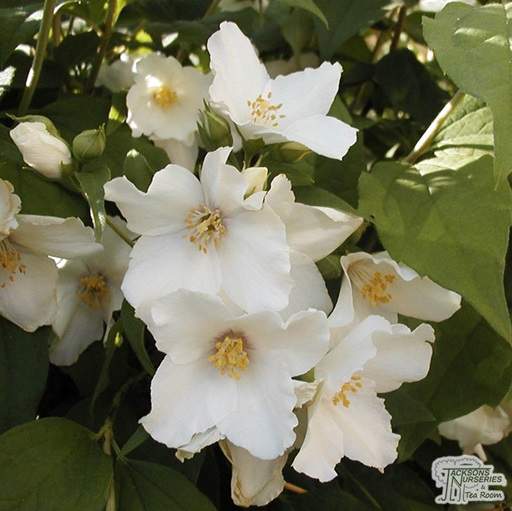
Hardy mid-sized evergreen bush with colourful foliage, ideal for the middle of a border or large container. Copes well with hard pruning and can be trimmed to form an informal hedge or clipped into strong shapes.
The staple Photinia Red Robin is ever popular with bright red young bracts that turn to green as the leaf matures. Choose Photinia Little Red Robin for a miniature version of Red Robin with foliage perfectly in proportion and even brighter than its big brother. Alternatively, Photinia Louise for colourful variegated green and cream mature foliage and 2-3 flushes of attractive new shoots with pink and rosy red markings each year or Photinia Pink Marble for multi-variegated green, cream, pink & red leaves.
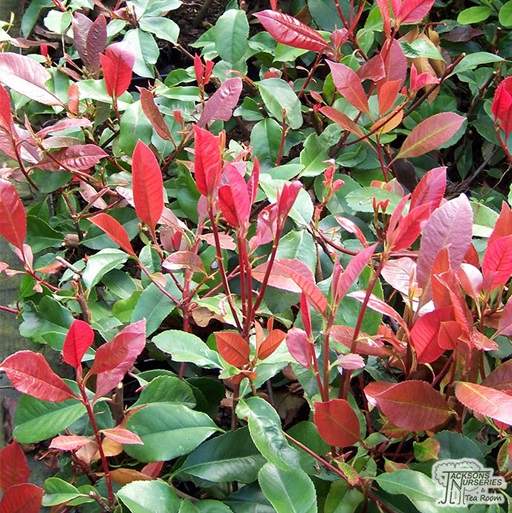
Small, compact evergreen bush grown for its attracting elongated foliage which is striking deep red when young and clusters of bell-shaped flowers in spring.
Choose Pieris Flaming Silver for attractive variegated foliage with bright red new growth in spring and clusters of white spring flowers, Pieris Forest Flame for bright red young bracts that turn creamy pink through to green as the leaf matures and creamy/ivory coloured flowers in late spring or Pieris Katsura for terrific wine-red coloured young growth and a plentiful supply of rose-pink flowers in elegant racemes in spring.

Indispensable small deciduous shrub with a long flowering season from March through September which makes it a must for any garden. Flowers are produced above a compact mass of finely divided, lance-shaped deciduous light green leaves that turn coppery orange in autumn. Makes an unusual and delightfully informal long flowering hedge or equally good in the mixed border.
Choose Potentilla Abbotswood for profuse white blooms with yellow centres throughout the summer, Potentilla Elizabeth for masses of beautiful bright yellow flowers resembling wild roses and Potentilla Princess for profuse, large yellow-centred pink flowers which fade to white at the edges. Alternatively, Potentilla Sunset has pretty, cup-shaped rich orange flowers fading to yellow in the centre.

Commonly known as laurel, Prunus is a staple for any garden offering a compact habit and glossy green leaves that make a perfect backdrop for more showy plants. Some varieties also make an excellent hedge. Easy to grow and trouble-free.
Prunus Rotundifolia is common Laurel, ideal for using as a strong-growing, evergreen hedge or screen with spikes of small white flowers in mid-spring followed by small black berries. Choose Prunus Otto Luyken for spikes of white flowers in late spring, followed by cherry-like red then black berries above a compact mass of stiff, glossy, dark evergreen leaves, Prunus Zabeliana as a low-growing variety with narrow, willow-like foliage, horizontal branches and erect panicles of small white flowers or Prunus Lusitanica for slender racemes of early summer, cup-shaped white flowers and a form dense enough to be used as a nesting site for birds.

Evergreen shrub producing masses of stunning berries in large clusters in autumn which will last well into the winter if they're not nabbed by the birds! It has a compact growth habit and forms a dense, thorny mass of elongated, light green foliage. Extremely tough and tolerant of a wide range of demanding conditions.
Choose Pyracanthus Orange 'Cadange' for masses of profuse, bright orange berries that makes an attractive freestanding shrub or intruder-proof hedge, Pyracanthus Red Cushion for clusters of orange-red berries and lots of pretty white flowers in the summer or Pyracantha Soleil D'Or for dense clusters of white flowers in summer followed by bunches of spherical bright yellow berries throughout the winter.

Rosemary is a medium-sized bushy evergreen shrub/formal hedge with long, narrow leaves and attractive hooded flowers from early to mid-summer. Prefers a position in full sun in a fertile, well-drained soil.
Choose Rosemary Miss Jessopps Upright for narrow dark green leaves with white undersides and small blue hooded flowers in May/June or Rosemary Officinalis Prostratus as a trailing variety for hanging baskets and patio pots with runners that become laden with lovely pale blue flowers.

Salix
Deciduous bush producing masses of narrow, silvery-green showy male catkins in spring on stiff branches with ovate, grey-green, slightly toothed foliage.
Choose Salix Wehrhahnii for erect branches and a rounded, spreading growth habit and catkins borne on purplish-brown shoots which give the effect of the branches being covered in icicles. Alternatively, Salix Chrysocoma has hairy silvery-green leaves with wavy margins on woolly young branches which thicken as they mature. Lanata produces erect, golden-yellow male catkins followed by small seeds in July and is tolerant of strong winds.

Ornamental shrub with arching branches and very finely cut, almost feathery leaves. Bred from our native elder which will grow almost anywhere including difficult conditions such as waterlogged or very chalky ground.
Choose Sambucus Black Lace for striking, very finely cut, almost black foliage, which makes the perfect backdrop for its pink-flushed blooms and turns to a stunning rich red in autumn or Sambucus Plumosa Aurea for bronze young leaves turning golden yellow as they mature, which is seen at its best in dappled shade. Plumosa Aurea produces small creamy flowers in late spring to early summer, followed by glossy red fruit, providing year round interest and a good source of food for wildlife.

Small pretty evergreen bush producing large panicles of beautiful bell-shaped inflorescent flowers usually from March to April above glossy green leaves.
Choose Skimmia Fragrans Cloud for tightly packed pinkie lime green buds through winter which open out into large panicles of beautifully perfumed two-toned pale pink and white flowers on short red stems or the popular Skimmia Rubella for deep purple/rich red tight flower buds during autumn and winter opening to panicles of sweetly scented white flowers through spring with occasional summer/autumn berries. Alternatively, Skimmia Veitchii produces dense clusters of white star shaped flowers in spring followed by waxy red spherical berries.

Mid-sized deciduous shrub with graceful, arching branches and toothed leaves which makes a wonderful addition to a sunny, well-drained border in any garden.
Choose Spiraea Arguta for a handsome, early-flowering variety that becomes festooned with dainty, pure white flowers between March and April, Spiraea Genpei for a dwarf with a mound-forming habit and attractive, red flowers fading to pink, and then to pure white giving an unusual, yet effective, tricolour effect, or Spiraea Gold Mound for an exceptional accent or contrast to a foundation planting or shrub border with brilliant foliage that holds its light chartreuse-green colour all season long with flushes of pink flowers from June to July.

Small, deciduous shrub with erect stems, a compact, upright rounded form and pointed dark green leaves. Bears an abundance of showy, fragrant, wildlife-attracting flowers in May and makes an excellent, informal flowering hedge.
Choose Syringa Miss Kim for dark lavender-pink buds fading to soft lavender-pink when fully opened and brilliant purple-red autumn foliage, Syringa Charles Joy for extremely fragrant, deep purple magenta blooms produced in dense clusters from late spring through early summer or Syringa Primrose for fragrant, single creamy-yellow flowers emerging from yellow buds and held in large, rounded trusses.

Fantastic evergreen or deciduous bush with large, leathery, dark green leaves decorated with distinctive veining and producing small flowers arranged in flattened clusters at the branch tips in late spring followed by berries. It has a compact, dome-shaped habit making it ideal for using in groups as ground cover.
Choose Viburnum Davidii for clusters of small white flowers in late spring above deeply veined foliage, followed by vibrant, metallic blue egg-shaped fruits, Viburnum Anne Russell for intensely serrated and attractively veined foliage and showy heads of bold, eye-catching creamy white flowers or Viburnum Dawn for dense clusters of highly fragrant pink flowers, great for growing near to entrances or paths.

Small evergreen bush with elegant, arching branches and oval, glossy mid-green leaves. Flowers are produced in mid-spring and last throughout the summer. Low maintenance ground cover great for suppressing weeds and adding colour.
Choose Vinca Major for an attractive trailing vine with deep violet blooms which gradually fade to white in the centre, Vinca Variegata for attractive creamy-yellow edged foliage and violet-blue blooms that are great for floral arrangements or brightening up shaded areas under the canopies of trees (vigorous) and Vinca Minor for smaller spaces, window boxes, containers or hanging baskets (smaller and slower growing).

Compact deciduous bush producing clusters of trumpet shaded, dark pink or purple flowers on arching branches which emerge from red buds between late spring and early summer. A garden classic that's perfect for adding impact to the front of a sunny border or smaller spaces in the garden.
Choose Weigela Foliis Purpureis for clusters of single, trumpet-shaped flowers and deep purple-brown leaves that become more intensely coloured the more sun the plant receives, Weigela Monet for a dwarf variety with dazzling creamy-white variegation that becomes strikingly flushed with deep pink when scorched by the sun or Weigela Nana Variegata for cream-variegated leathery leaves which compliment the showy, trumpet-shaped rose-pink flowers beautifully.

-
Plant Guides
- Guide to Bamboo Plants
- Guide to Climbing Plants
- Guide to Climbing Roses
- Guide to Conifers
- Guide to Floribunda Roses
- Guide to Fruit Bushes
- Guide to Fruit Trees
- Guide to Garden Ferns
- Guide to Garden Shrubs
- Guide to Heather Plants
- Guide to Hedging Plants
- Guide to Herb Plants
- Guide to Herbaceous Perennials
- Guide to Hybrid Tea Roses
- Guide to Japanese Maple Trees
- Guide to Ornamental Grasses
- Guide to Rhododendrons
- Guide to Topiary
Share this page:







